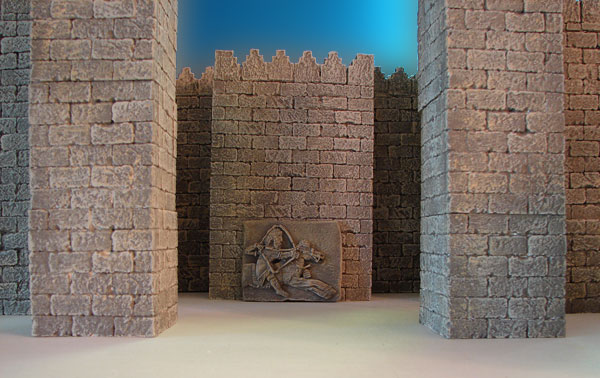|
|
|
 |
The Bible
Mentions Asnapper (Ashurbanipal).
This miniature relief shows Asnapper hunting with bow pulled.
This is reminiscent of the first hunter of Assyria in Genesis
named Nimrod. The Bible mentions
king Asnapper in Ezra 4:10 |
This miniature replica is of Ashurbanipal,
King of Assyria, from his palace at his ancient capital, Nineveh. His
Biblical name was Asnapper. The panel was discovered at the site of ancient
Nineveh during the reign of Ashurbanipal (668-626 BC). He is shown
hunting on horseback with his bow pulled back ready to shoot an arrow. The original is
located at the British Museum in London. The alabaster relief is part of
a panel standing over 25 inches tall.
Ezra 4:10 - and the rest
of the nations whom the great and noble Asnapper brought
over, and set in the city of Samaria, and in the rest of the country
beyond the River, and so forth, wrote.

This map shows the primary capitals of the Neo-Assyrian Empire
Museum Images
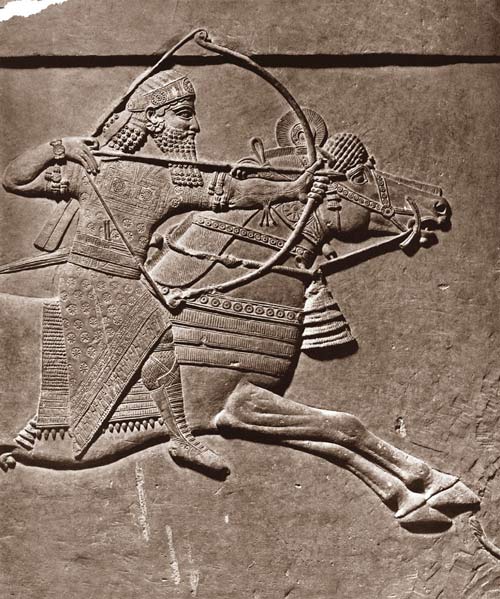
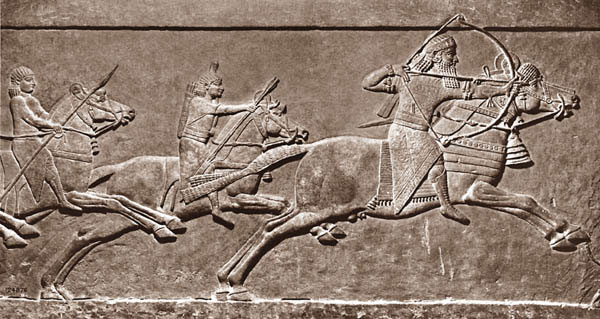
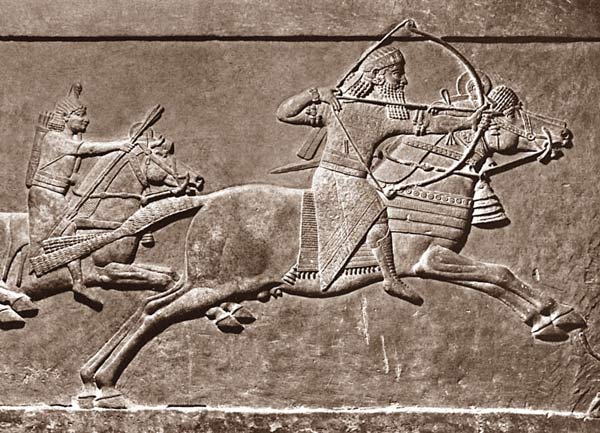
King Ashurbanipal Hunting
Information about the Ashurbanipal
Hunting Relief
- Limestone relief from the N. palace of
Ashurbanipal at Nineveh, his capital.
- Ashurbanipal reigned from 668-626 BC.
- Ashurbanipal was the grandson of Sennacherib and son of Esarhaddon
- The detailed relief stands 63.5 cm (25 inches) tall.
- actual dimensions of the detail are
w. 3 ft. 8 in. h. 1 ft. d. 8 3/4 in.
- The relief reveals a royal hunt for Gazelle, lions, and other animals
- The King of Assyria is on horseback with bow stretched
- The king's servants are following behind with arrows and a spear
- The panel shows the King of Assyria with his attendants and horses
- From the Neo-Assyrian Period (1000-612 BC).
- Excavated at the site of ancient Nineveh (Kuyunjik) by H. Rassam about
1847.
- The royal hunt is seen throughout Assyrian history
- The theme of the hunt was very popular in Neo-Assyrian royal art.
- The Bible called Nimrod a mighty "hunter" before the LORD
- This stone panel was is currently at the British Museum.
- Nineveh (Kuyunjik) was Ashurbanipal's capital city (Northern Iraq).
- Ashur-bani-pal was one of the most energetic and cruel of the Assyrian
kings
An actual inscription from
Ashurbanipal himself:
" I am Ashur-bani-pal, king of
hosts, king of Assyria. In my abounding, princely strength I seized a
lion of the desert by his tail, and at the command of Enurta and Nergal,
the gods who are my helpers, I smashed his skull with the axe in my
hands." He goes on to say " I am Ashur-bani-pal, king of hosts, king of
Assyria, whom Ashur and Belit have endowed with might. Against the lions
that I slew I directed the powerful bow of Ishtar, the lady of battle,
and I made an offering and poured out a libation over them."

Museum Excerpt
Museum number ME 124875
Stone panels from the North Palace of
Ashurbanipal (Room S, nos. 13-18)
Nineveh, northern Iraq
Neo-Assyrian, 669-630 BC
Hunting Gazelle and Lions
This is part of a series of sculptures which decorated a private gate
chamber in the palace of King Ashurbanipal (reigned 669-630 BC).
The scenes are arranged in three registers, and are similar to those on
other relief panels fallen from an upper storey, and the large-scale
versions in the corridor leading to the gatehouse. They often centre on
lion-hunting; there was a close association between royalty and lions in
ancient Mesopotamia. Unlike many of the reliefs, which act like a comic
strip with the action moving in one direction, this one appears as a
snapshot. Some of the gazelle, alarmed by a beater on the right, flee
towards Ashurbanipal, who is hidden in a pit armed with bow and arrows.
Herds of gazelle were once widespread in the Near East. They represented
one of the main sources of meat for the people of the region. Ancient
recipes survive for gazelle stew. Indeed, gazelle are said to have been
common in Assyria as late as the 1950s though now they are only found in
the remotest corners of Arabia. Modern firearms and motorized transport
have almost driven these animals to extinction in this part of the
world.
"Alabaster wall panel; relief; on the
bottom a scene of hunting gazelle; herd of gazelle disturbed by
huntsmen; one looks round, tries to escape and is led into ambush;
Ashurbanipal waits in a pit with a bow and shoots the leader down; also
on the bottom row is a scene showing the hunting of wild asses; the king
gallops forward, shooting at wild asses; one of the horsemen behind him
has a supply of arrows while the other leads a spare mount; the asses
are shot or pulled down by hounds; one is lassoed alive, probably for
breeding; on the middle row is a lion hunt on horseback; Ashurbanipal
drives a spear into one lion's mouth but another, which has been hit by
arrows and left for dead, leaps up to maul the king's spare horse;
attendants gallop to the rescue from the left; in the next episode, to
the right, the king has killed both lions; some attendants admire them
and others, kneeling in disgrace, probably allowed their horses to lag
too far behind the king; the bottom row shows Ashurbanipal on foot,
killing a lion; the lion is released from a cage by a small person,
possibly a child, who has his own cage to hide in; the lion advances on
the king and is hit by an arrow; finally, on the left, the king
dispatches lion with sword."
Dimensions
Height: 63.500 cm
Width: 71.120 cm
The palace was excavated by H. Rassam
(from 1853)
British Museum Page
 The Assyrian
Empire The Assyrian
Empire
The first great military empire in ancient history
was the Assyrian Empire. By the time of Ashurnasirpal and Shalmaneser
III in the 9th century BC the Assyrians organized a mighty army of
nearly 200,000 soldiers. Their military strategy was unsurpassed up to
that time, and with the age of iron they were an unstoppable fighting
machine. They brought spearmen, archers, shieldmen, slingers, siege
engines, chariots, and a huge calvary into the battlefield. The mighty
Assyrians dominated the ancient world until they were crippled by the
God of Israel in the reign of Sennacherib. God raised up the Assyrians
to remove Israel out of his sight for their rebellion and idolatry, but
the Assyrians would also be punished also for their wicked ways. They
finally fell to the Medes and Babylonians in 612 BC and passed into
history.
 Assyrian Kings Mentioned in the Bible
Assyrian Kings Mentioned in the Bible
2 Kings 15:29 -
In the days of Pekah king of Israel, Tiglath
Pileser king
of Assyria came and took Ijon, Abel Beth Maacah, Janoah, Kedesh, Hazor,
Gilead, and Galilee, all the land of Naphtali; and he carried them
captive to Assyria.
2 Kings 15:19 - Pul the
king of Assyria came against the land, and Menahem gave Pul one thousand
talents of silver, that his hand might be with him to confirm the
kingdom in his hand.
2 Kings 18:9 -
And it came to pass in the fourth year of king Hezekiah, which [was] the
seventh year of Hoshea son of Elah king of Israel, that Shalmaneser king
of Assyria came up against Samaria, and besieged it.
Isaiah 20:1 -
In the year that Tartan came unto Ashdod, when Sargon the
king of Assyria sent him,) and fought against Ashdod, and took it;
2 Kings 19:16 -
LORD, bow down thine ear, and hear: open, LORD, thine eyes, and see: and
hear the words of Sennacherib,
which hath sent him to reproach the living God.
2 Kings 19:37 -
And it came to pass, as he was worshipping in the house of Nisroch his
god, that Adrammelech and Sharezer his sons smote him with the sword:
and they escaped into the land of Armenia. And Esarhaddon his
son reigned in his stead.
Ezra 4:10 - and the rest
of the nations whom the great and noble Asnapper brought
over, and set in the city of Samaria, and in the rest of the country
beyond the River, and so forth, wrote.
Assyrian Kings Names in Cuneiform
Archaeology
of Ancient Assyria
Timeline of Ancient Assyrian Kings
(During the Period of the Biblical Kings)
Assur-nasirpal II (885-860
B.C.) A cruel warrior king, he made Assyria into the most fierce
fighting machine of ancient world.
Shalmaneser III (860-825
B.C.) His reign was marked by almost constant war. He was the first
Assyrian king to come into conflict with Israel. King Ahab fought
against him, and king Jehu paid him tribute in 841 BC. His royal
inscriptions were more detailed and more numerous than any other king.
His building works were massive just like his father Assurnasirpal II.
See Shalmaneser
and the Black Obelisk.
Shamsi-Adad V (825-808
B.C.) Most of his reign was focused on Babylonia and his own internal
conflicts.
Adad-nirari III (808-783
B.C.) The little information about his reign mentions his building
projects at Calah and Nineveh, as well as a conflict at Der in Babylonia
and collecting tribute in Damascus, Syria.
Shalmaneser IV (783-771
B.C.) The limited knowledge of his reign reveal some conflicts in
Damascus and a period of decline in Assyria.
Assur-dayan III (771-753
B.C.) The little information about this ruler reveals Assyria being in a
period of decline.
Assur-nirari V (753-747
B.C.) There is very little information about his reign. The king of
Urartu boasted of a victory over this king of Assyria in an inscription.
Tiglath-pileser III (Pul)
(747-727 B.C.) He restored Assyria to a major world power. He is the "Pul"
mentioned in the Bible and the one who began to destroy Samaria, the
capital of the Northern Kingdom of Israel. He carried many away into
captivity. This captivity is mentioned in his own inscriptions, the
Babylonian Chronicle, and the Bible.
Shalmaneser V (727-722
B.C.) He besieged Samaria, the capital of the Northern Kingdom of
Israel. He died during the siege after imposing taxation on the holy
city (Asshur), and his son Sargon came to power.
Sargon II (722-705
B.C.) He completed the destruction of Samaria and the captivity of
Israel. He was also famous for his magnificent palace with his colossal
winged guardians.
Sennacherib (705-681
B.C.) He was the most famous of the Assyrian kings. He mentions the name
of Hezekiah on his prism during his war campaigns, he claimed to have
"Hezekiah captured in his own royal city (Jerusalem) like a caged bird."
His army was defeated at the gates of Jerusalem by the Angel of the
Lord. Sennacherib returned back to Nineveh and was killed violently by
his own son, as mentioned in the Babylonian Chronicle, The Bible, and
various other inscriptions. He also conquered Babylon.
Esar-haddon (681-668
B.C.) He rebuilt Babylon, invaded and conquered Egypt by crossing over
the Sinai Desert with Arab camels carrying water for his army, and was
one of Assyria's greatest kings. He died fighting Egypt.
Assur-banipal (668-626
B.C.) He destroyed the Thebes in Egypt and collected a great library,
innumerable clay tablets were found.
Assur-etil-ilani (626-607
B.C.) It was under his reign that the Assyrian Empire fell.
 Assyrian
annals mention contacts with some ten Hebrew kings: Omri, Ahab, Jehu,
Menahem, Hoshea, Pekah, Uzziah, Ahaz, Hezekiah, and Manasseh. Assyrian
annals mention contacts with some ten Hebrew kings: Omri, Ahab, Jehu,
Menahem, Hoshea, Pekah, Uzziah, Ahaz, Hezekiah, and Manasseh.
In the reign of Hoshea, king of Israel, Shalmaneser, king of
Assyria, twice invaded (2 Kings 17:3,5) the kingdom that remained, and
his successor Sargon II took Samaria in 722 BC, carrying away 27,290 of
the population as he tells in his Khorsabad Annals. Later Assyrian
kings, particularly Esarhaddon (681 BC - 668 BC), completed the task.
For More Info See:
Bible History Online
Map of the Land of Assyria
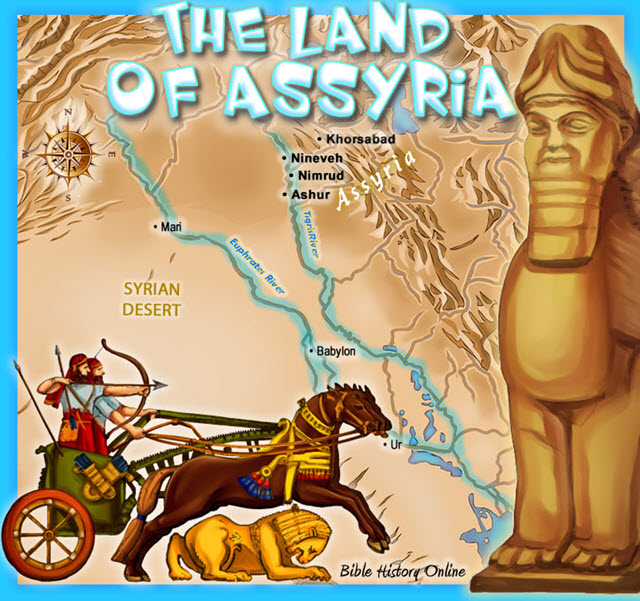
Kids Bible Maps
Primary Sources for Assyrian History
The Assyrian Annals. The scribes of the chief cities of the
Assyrians wrote the accounts of the king's military campaigns on
cuneiform tablets, and clay prisms or cylinders. The accounts are very
reliable, even though the accounts do not speak negatively of the
Assyrians and are meant to glorify the king. The annals also give much
detail to geography and Chronology. It is interesting how accurate the
Assyrians were with dates, they made use of an Assyrian Kings List or
the Eponym Canon.
The Assyrian Chronicles and Eponym Canon. The Assyrian scribes
organized their national events whether military, political or religious
every regnal year. The Babylonian Chronicles were structured the same
way. Assyrian records were kept very carefully, they took their dating
and their history seriously. They attached their record of events with
the solar year and with the name of an official who was known as the "limmu."
Their was a new limmu appointed every year. They recorded military,
political and religious events in every year and made references to
eclipses. The Assyrian records are highly dependable and allow Biblical
scholars a very accurate way of dating events and designating "eponyms"
for 244 year in Hebrew history, from 892-648 BC.
The Assyrian King List.
The Assyrian King List reveals a list of the kings of ancient
Assyria in chronological order, from the 2nd millennium BC to 609 BC. It
lists the name of the king, his father's name, the length of his reign,
and some great achievements.
Assyrian Sculptures. The limestone bas-reliefs discovered
from the palace walls of major Assyrian capital cities like Nineveh (Kuyunjik),
Nimrud (Calah), Khorsabad (Dur-Sharrukin), and the bronze bands on the
Balawat Gates reveal a wealth of history. The illustrative events were
carved be professional Assyrian artists like a modern day photographer
on the scene. The carvings reveal the military might and tactics of the
Assyrians, as well as the futility of those nations that defied their
might. These sculptures are on display in museums around the world, for
example: The British Museum in London, The Louvre in France, The Iraqi
Museum, and The Oriental Institute in Chicago.
The Bible. The Old Testament records the history of the Kingdoms
of Israel and Judah, along with the battles of other nations. It
includes the fall of the 10 tribes in northern kingdom of Israel in 722
BC by the Assyrians, as well as the
fall of the southern kingdom of Judah in 586 BC by Nebuchadnezzar of
Babylon. The Bible also records miraculous events surrounding people
like Elijah, and Jonah, as well as the slaying of 185,000 Assyrians at
Jerusalem by the Angel of the LORD. The events recorded in 2 Kings
generally agree with Assyrian and Babylonian sources. |
